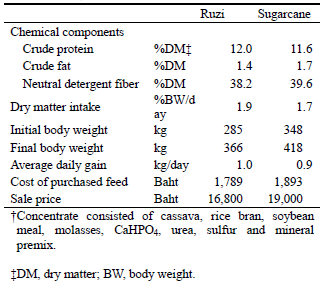Utilization of sugarcane silage as feed for beef cattle in Northeast Thailand
Description
Northeastern Thailand is the biggest region of beef cattle production in Thailand. Most beef cattle are raised on small mixed farms. It is generally recognized that the shortage of forage in the dry season is the chief factor limiting beef cattle production in the region. Additionally, hay and silage preservation is not easy, because of frequently unsuitable weather for forage drying during the rainy season and low fermentable substrate content in tropical grasses for silage fermentation. Sugarcane, which is planted widely in this region, has high amounts of fermentable substrates, i.e., sugars, and gives high yields. Therefore, there is the potential for preparing reliable and high-quality silage that will provide a steady supply of food throughout the year. This study aimed to make and evaluate sugarcane silage, and to investigate the effect of sugarcane feeding on growth performance in beef cattle.
Pangola grass (Digitaria eriantha), which was cut at early bloom, and sugarcane, which was harvested at around six months after regrowth, were chopped and ensiled in plastic bags, then evaluated for their chemical components and quality six months later. Crude protein content in sugarcane silage was lower than that in pangola grass silage (Table 1). On the other hand, the lactic acid content was higher for sugarcane silage than pangola grass silage, and pH and spoilage ratios due to molds were lower for sugarcane silage than pangola grass silage. These results show that the fermentation quality of sugarcane silage was higher than that of pangola grass. Total digestible nutrient content, digestible energy content and metabolizable energy content of the sugarcane silage were respectively 49.6% DM, 9.7 MJ/kgDM and 7.8 MJ/kgDM. A feeding experiment with the beef cattle diet was conducted at a beef cattle raising farm in Khonkaen District. Six American Brahman crossbred bulls (around 18 months old) were separated into two groups, one of which was fed Ruzi grass (Brachiaria ruziziensis) hay with concentrate and the other sugarcane silage with concentrate. Both groups were fed the same roughage-to-concentrate ratio (38:62) for three months. The results showed that an average daily gain of 0.9 kg/day could be achieved with sugarcane silage during the feeding period (Table 2).
It is possible to supply silage which of good and reliable quality using sugarcane, and to raise beef cattle using sugarcane silage as the basic diet. However, sugarcane silage needs to be consumed as soon as possible after opening due to its low aerobic stability.
Figure, table
-
Table 1. Chemical components and fermentation quality of pangola grass silage and sugarcane silage.
-
Table 2. Feed chemical components and performance of beef cattle fed Ruzi grass hay or sugarcane silage with concentrate†
- Affiliation
-
Japan International Research Center for Agricultural Sciences Animal Production and Grassland Division
- Classification
-
Technical A
- Term of research
-
FY2002~2005
- Responsible researcher
-
SUZUKI Tomoyuki ( Kyushu Okinawa Agricultural Research Center, NARO )
NISHIDA Takehiro ( Animal Production and Grassland Division )
PHAOWPHAISAL Ittiphon ( Khon Kaen Animal Nutrition Research and Development Center )
PONRAGDEE Werapon ( Khon Kaen Field Crop Research Center )
- ほか
- Publication, etc.
-
Suzuki, T., H. Kawamoto, I. Phaowphaisal, W. Ponradgee, P. Pholsen, R. Narmsilee, S. Indramanee, S. Oshio (2006): Fermentation Quality and Nutritive Value of Whole Crop Sugarcane Silage. JIRCAS working report No. 47, 93-95.
Phaowphaisal, I., T. Suzuki, S. Indramanee, S. Oshio (2006): Cattle Feeding is Now Popular in Village. JIRCAS working report No. 47, 125-128.
- Japanese PDF
-
2005_seikajouhou_A4_ja_Part12.pdf477.66 KB


